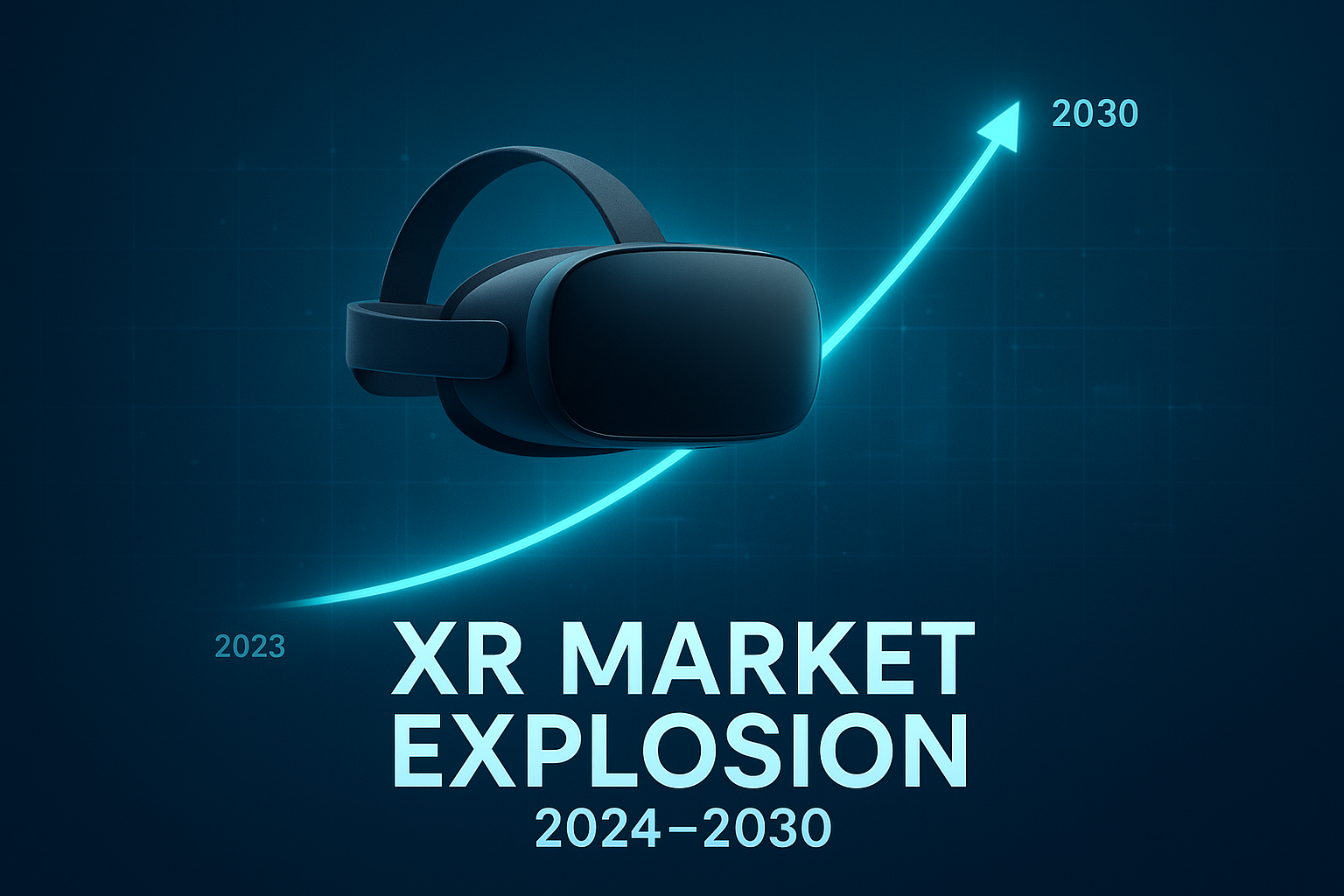Samsung Galaxy XR: An Expert Analysis of Market Strategy, Competitive Positioning, and the Open-Ecosystem Challenge
1. Executive Summary: Samsung’s Dual-Pronged XR Offensive
The launch of the Samsung Galaxy XR marks a highly strategic and calculated entry into the nascent Extended Reality (XR) market. The device is overtly positioned as the high-fidelity, open-ecosystem disruptor, designed to capture the lucrative intersection of the premium consumer and emerging enterprise markets. This positioning is reinforced by its aggressive pricing: at $1,799, the Galaxy XR establishes itself as a competitive challenger to the ultra-premium segment, undercutting the Apple Vision Pro (AVP) by nearly 50%.
Samsung’s strategy hinges on three core competitive levers that seek to address known limitations in the high-end XR space:
- Price-to-Performance Superiority: The Galaxy XR delivers higher total pixel count (29 million) through dual 4K Micro-OLED displays compared to the AVP’s 23 million pixels. Furthermore, its lighter weight (545 grams versus AVP’s 750 grams) prioritizes comfort and sustained use, a critical factor for both enterprise training and extended media consumption.
- Open Ecosystem Advantage: Leveraging the new Android XR platform, developed in collaboration with Google and Qualcomm, Samsung directly mitigates the primary industry restraint—content scarcity. This open ecosystem, anchored in OpenXR standards, immediately ensures access to millions of existing Android apps and encourages rapid developer adoption, bypassing the “walled garden” limitations of proprietary platforms.
- AI as a Bridge to Utility: The deep integration of Google’s Gemini AI transforms the device from an experimental gadget into a functional, multimodal productivity and assistance tool. Samsung is betting that this focus on practical, AI-driven utility will convince high-end users that XR offers enduring value beyond mere novelty.
However, the strategy is not without risks. Key challenges include facing Apple’s superior M-series processing power, proving the robustness and maturity of the newly launched Android XR developer community, and overcoming market sensitivity to the $1,800 price point, which remains significantly above mainstream consumer levels like the Meta Quest 3.

2. Global Extended Reality (XR) Market Dynamics and Segmentation
This section establishes the market validation and quantifies the scale of the opportunity that Samsung is strategically attempting to enter.

2.1. Macroeconomic Drivers and Market Forecast
The strategic timing of the Galaxy XR launch is validated by the exponential growth projections for the global XR market. Valued at $142.39 billion in 2023, the market is projected to reach $1,069.27 billion by 2030, reflecting a robust Compound Annual Growth Rate (CAGR) of 32.9% between 2024 and 2030. While a slightly more conservative estimate projects growth at a CAGR of 28.3% to $84.86 billion by 2029, the consensus confirms an explosive trajectory driven by increased spending, rising government support, and high demand for improved visual information.
Geographically, North America currently holds the distinction of being the largest market based on 2023 data. However, emerging regions such as the Middle East & Africa are projected as the fastest-growing sectors, indicating substantial global scaling opportunities for companies capable of producing high-quality, standardized hardware.
A crucial prerequisite for high-fidelity XR adoption is technological infrastructure. The expansion of 5G connectivity is cited as a significant accelerator, as it enables the low-latency, ultra-reliable use cases essential for real-time mixed reality experiences, such as shared collaborative work environments or high-definition streaming. Recognizing this requirement, the Galaxy XR platform, powered by the Snapdragon XR2+ Gen 2 chipset, integrates cutting-edge connectivity supporting Wi-Fi 7 and Wi-Fi 6E. This optimization for high-speed, low-latency wireless performance ensures the device is positioned to exploit the full potential of global 5G rollouts for bandwidth-intensive XR applications.
2.2. Market Segmentation: Consumer HMDs as the Primary Growth Engine
The overall XR market is segmented across diverse end-user industries, including education, retail, industrial and manufacturing, healthcare, and media & entertainment. Despite the clear value propositions in the B2B sector (discussed further in Section 4), the consumer segment remains the driving force for rapid adoption and market scaling.
Consumer head-mounted displays (HMDs) are forecasted to reach 90.1 million shipments by 2027, growing at an accelerated Compound Annual Growth Rate of 36.1%. This growth rate, which exceeds the overall XR market CAGR, highlights that consumer demand, driven primarily by gaming, immersive entertainment, and the burgeoning interest in spatial computing, is providing the necessary scale and momentum for infrastructure development across the entire industry. Consequently, the high-stakes battle between Samsung, Apple, and Meta for dominance in premium HMD hardware is critical, as success in this segment dictates the future direction of the platform ecosystem.
2.3. Market Headwinds and Strategic Mitigation
Before the Galaxy XR launch, the XR industry faced significant headwinds that hindered mainstream adoption. These constraints included high initial costs for hardware and software, a persistent shortage of high-quality, diverse XR content, health and safety concerns (such as motion sickness and eye strain), and increasing cybersecurity risks related to connected devices.
Samsung’s strategy directly targets several of these key restraints. By pricing the Galaxy XR at $1,799, the company significantly reduces the financial entry barrier compared to the AVP, aiming to make premium XR more accessible to a broader prosumer demographic. Furthermore, the open Android XR platform is designed specifically to immediately mitigate content limitations. Finally, ergonomic design choices, such as the lighter 545-gram frame and the adjustable strap, are a direct attempt to address wear fatigue and user discomfort, which often leads to poor compliance in both consumer and enterprise settings.
Table 1: Global XR Market Forecast and Consumer HMD Growth
| Metric | Value (2023) | Projected Value | CAGR |
| Global XR Market Size (USD Bn) | $142.39 Billion | $1,069.27 Billion (2030) | 32.9% (2024-2030) |
| Consumer HMD Shipments (Units) | N/A | 90.1 Million (by 2027) | 36.1% (by 2027) |
3. Competitive and Business Model Analysis: The Triad Showdown
The competitive landscape of premium XR is currently defined by a triad of major players: Meta (volume leader), Apple (premium exclusivity), and now Samsung (price-to-performance leader).

3.1. Price-Point Disruption and Strategic Positioning
The $1,799 price point of the Galaxy XR is its most forceful strategic move. By pricing itself nearly half that of the Apple Vision Pro ($3,499), Samsung immediately injects aggressive price competition into the high-end market. This creates a “Prosumer Sweet Spot”—a vital market segment composed of developers, early-adopting professionals, and high-end enthusiasts who demand top-tier specifications and an advanced mixed-reality experience but are unwilling to bear Apple’s significantly higher cost and ecosystem restrictions. The Galaxy XR effectively bridges the massive price gap that previously existed between the Meta Quest 3 (~$500) and the Vision Pro, offering a high-quality alternative that validates the viability of mid-premium pricing.
3.2. Head-to-Head Technical Benchmarking: Visual Fidelity vs. Raw Power
A comparative analysis of the Galaxy XR against the Vision Pro reveals a deliberate strategy by Samsung to win on visual clarity and comfort, while accepting a trade-off in raw computing power.
The Galaxy XR achieves a significant visual fidelity advantage through its dual 4K Micro-OLED displays, providing a resolution of 3,552 x 3,840 pixels per eye. This equates to approximately 29 million total pixels, which exceeds the Vision Pro’s 23 million total pixels. Industry analysis suggests this superior pixel density results in a notably crisper picture and cleaner, more readable text within productivity applications. This technical superiority in display resolution at a lower price point is a direct challenge, suggesting that Samsung deliberately chose visual performance as its primary consumer value driver. However, the Galaxy XR’s maximum refresh rate is 90Hz or 100Hz, slightly below the Vision Pro’s 120Hz maximum, which may offer smoother motion in high-speed scenarios.
In terms of processing capability, the Galaxy XR is powered by the mobile-optimized Qualcomm Snapdragon XR2+ Gen 2 chipset. This component is designed for efficiency and integration within the Android ecosystem. The AVP, in contrast, utilizes Mac-grade M-series chipsets (M2 or M5), which analysts note provide significantly greater raw processing power. While the AVP holds an edge in sheer local compute capability for demanding graphics rendering, the Galaxy XR focuses on leveraging the Snapdragon chip’s optimized performance for standalone XR operations and seamless integration with cloud-based AI services like Gemini.
Ergonomics represents another major competitive differentiator. Comfort is critical for market success, particularly as the industry attempts to establish XR headsets as daily computing tools. The Galaxy XR weighs 545 grams, making it nearly 200 grams lighter than the 750-gram Vision Pro. This lighter weight, coupled with an adjustable strap, is specifically designed to facilitate prolonged sessions necessary for B2B applications like industrial training and for consumer media consumption, providing better user compliance than the heavier, front-loaded design of the AVP. Both devices utilize external, tethered battery packs to manage weight distribution, though the Vision Pro’s latest iterations claim a slight advantage in general use battery life (up to 2.5 hours compared to the Galaxy XR’s estimated two hours general use).
3.3. Business Model Comparison: Open Collaboration vs. Vertical Integration
The strategic distinction between Samsung and Apple is most pronounced in their ecosystem models.
Samsung, along with Google and Qualcomm, embraces an Open/Horizontal model centered on Android XR and OpenXR standards. This strategy is designed to encourage rapid developer participation, reduce barriers to entry for content creators, and ensure compatibility with a wide range of future Android XR devices. The openness mitigates content risk and positions the platform for universal scaling.
Conversely, Apple employs a Closed/Vertical model. Its visionOS is proprietary and tightly integrated solely with Apple hardware and services. While this guarantees a highly polished user experience and deep optimization, the resulting “walled garden” limits external developer participation, potentially slowing the proliferation and diversity of essential applications.
Table 2: High-End XR Headset Competitive Comparison
| Feature | Samsung Galaxy XR | Apple Vision Pro (AVP) | Meta Quest 3 |
| Starting Price | $1,799 | $3,499 | ~$500 |
| Operating System | Android XR (Open) | visionOS (Closed) | Meta Horizon OS |
| Total Pixels | 29 Million | 23 Million | Approx. 4.6 Million |
| Resolution (Per Eye) | 3,552 x 3,840 (4K) | Undisclosed | 2,064 x 2,208 (Approx.) |
| Chipset | Snapdragon XR2+ Gen 2 | Apple M-series (M2/M5) | Snapdragon XR2 Gen 2 |
| Headset Weight (Approx.) | 545g | 750g | 515g (Approx.) |
4. Corporate Strategy and Supply Chain Analysis
Samsung’s corporate strategy for the Galaxy XR is anchored in a sophisticated tri-party alliance designed to pool expertise, accelerate market entry, and establish a scalable long-term ecosystem.
4.1. The Strategic Tri-Party Alliance: A Shared Risk Model
The Galaxy XR is the result of a comprehensive alliance between Samsung (hardware), Google (OS and AI), and Qualcomm (silicon and enterprise platform). This collaborative approach, which differs profoundly from Apple’s vertically integrated model, spreads the enormous technical and financial risks associated with launching a new computing platform.
Samsung contributes premium hardware expertise, leveraging its prowess in display manufacturing to secure the superior 4K Micro-OLED panels. Google provides the fundamental Android XR operating system and the powerful Gemini AI layer, ensuring immediate software familiarity and functionality. Qualcomm delivers the specialized silicon, the Snapdragon XR2+ Gen 2, which is optimized for standalone XR efficiency, along with critical connectivity features like Wi-Fi 7. By adopting this shared risk model, Samsung can focus its core resources on hardware design and manufacturing scale while outsourcing the complex development of the OS and specialized B2B software infrastructure, significantly accelerating development and market readiness.
4.2. AI-Native Platform and Multimodal Computing
Samsung positions the Galaxy XR as the industry’s first “AI-native headset”. The deep integration of Google’s Gemini AI is central to its utility proposition. Gemini Live offers “conversational multimodal AI technology,” allowing users to interact with the device and content effortlessly using voice commands, hand gestures, and vision. This multimodal perception system enables Gemini to contextualize the user’s surroundings and activity, delivering contextual assistance within XR applications and throughout the operating system. This transformation of the device into a personalized, adaptive assistant is considered key to transitioning XR from a novelty item into a tool with tangible, lasting utility for everyday work and life.
4.3. Enterprise Go-to-Market Strategy (B2B)
Given the premium price point of $1,799, the enterprise sector represents a reliable near-term revenue stream for the Galaxy XR. Samsung has demonstrated commitment to B2B applications through dedicated pilot programs, such as the partnership with Samsung Heavy Industries to utilize the headset for virtual shipbuilding training, enhancing work productivity and safety.
Further supporting the B2B approach, the collaboration with Qualcomm integrates the Snapdragon Spaces platform. This technology is instrumental in fostering a dedicated Enterprise ISV (Independent Software Vendor) ecosystem, providing developers with essential tools to create optimized business solutions for Android XR. These collaborations are strategically vital for offering enterprise-ready XR capabilities such, as advanced training simulations, secure remote collaboration, and co-design of complex solutions, ensuring the Galaxy XR minimizes sales friction for large-scale corporate deployments.
4.4. Long-Term Roadmap: Scaling Beyond the Headset
The Galaxy XR is expressly defined not as a singular product but as the inaugural device in a multi-device roadmap. Samsung’s long-term vision positions the Android XR ecosystem to scale across various form factors, primarily targeting lightweight AI glasses.
To address the aesthetic and social barriers that typically inhibit daily AR adoption, Samsung has established high-profile partnerships with lifestyle and fashion brands. Collaborations with Warby Parker and Gentle Monster are intended to blend “cutting-edge AI-native technology with cultural influence and design leadership”. This strategy aims to normalize AR technology by integrating advanced capabilities with style, comfort, and practicality, moving boundary-free computing into daily life.
4.5. Supply Chain and Component Advantage
Samsung’s intrinsic corporate strength in display manufacturing provides a significant component advantage. The capacity to produce or source the superior 4K Micro-OLED displays provides the Galaxy XR with a competitive edge in visual quality, ensuring control over a critical high-end component and potentially reducing costs. Furthermore, Samsung adheres rigorously to supply chain transparency and ethical sourcing mandates, following the RBA Code and OECD due diligence guidance to ban the use of conflict-affected and high-risk minerals (such as tantalum, tungsten, tin, gold, and cobalt) throughout its supplier network. This ethical commitment is increasingly important for securing large-scale governmental and institutional enterprise contracts.
Table 3: The Android XR Strategic Alliance and Core Contributions
| Partner | Core Contribution | Strategic Advantage |
| Samsung | Hardware Design, Manufacturing, Micro-OLED Displays, Enterprise Pilots | Control over premium components; manufacturing scale; B2B readiness and internal validation. |
| Android XR Operating System, Gemini AI Integration, Base App Ecosystem | Instant content compatibility; cutting-edge conversational AI; unified, familiar user experience. | |
| Qualcomm | Snapdragon XR2+ Gen 2 Chipset, Snapdragon Spaces Platform, Connectivity | Optimized performance for standalone XR; dedicated Enterprise ISV pipeline; low-latency wireless experience. |
5. Content Strategy and Developer Engagement
The success of any new computing platform is predicated on its ability to rapidly amass a rich and diverse content library. Samsung’s content strategy for the Galaxy XR focuses on open standards and leveraging existing ecosystems to avoid the development drought that affects closed, proprietary platforms.
5.1. Overcoming the Content Barrier (Day One Utility)
The most potent element of the software strategy is the “Android bridge.” Android XR’s architecture allows all apps built on the standard Android platform to work “out of the box” on the Galaxy XR. This capability immediately provides millions of existing applications for day-one utility, effectively eliminating the risk of a “barren app store”.
Beyond mobile app compatibility, Samsung and Google have secured crucial strategic app integrations. XR-optimized versions of core Google services such as YouTube, Google Maps, and Google Meet are available at launch. Furthermore, the inclusion of productivity and media creation tools like Adobe’s Project Pulsar (a cinematic 3D editing application) emphasizes the headset’s appeal to professional users. To maximize immediate consumer appeal, the Explorer Pack bundles subscriptions like NBA League Pass and YouTube Premium, boosting immediate experiential value and solidifying the device’s media consumption capabilities.
5.2. Developer Accessibility and Open Standards
The foundation of the Android XR platform is built on OpenXR standards, which ensures maximum developer accessibility. Developers already using OpenXR, WebXR, or Unity can easily port their existing 3D experiences to the Galaxy XR, offering seamless scalability and reducing the learning curve associated with a new platform. The strong alliance with the development community is evidenced by Unity’s quick adoption, achieving “Verified status” for Android XR packages and providing developers with production-quality content creation tools immediately. This focus on open standards and popular development platforms minimizes the developer risk and cost associated with building for Android XR compared to proprietary systems like visionOS, allowing the ecosystem to rapidly scale in volume and diversity of applications.
5.3. AI as a Content Differentiator
The integration of Gemini AI is crucial for differentiating the Android XR content experience. Gemini is woven into the operating system to enhance functionality; for instance, it enables AI-assisted coaching and real-time tips within XR-specialized games. In productivity and guidance applications, Gemini Live uses the multimodal perception system to offer context-aware assistance, providing a highly intuitive layer of support for tasks like travel planning or system control. This emphasis on AI utility, especially in creation and enhanced experience tools like Adobe Project Pulsar, reinforces the Galaxy XR’s positioning as a premium device focused on practical function, not just entertainment novelty.
6. Strategic Conclusions and Outlook for Samsung’s XR Future
6.1. Verdict on the Galaxy XR’s Positioning
The Samsung Galaxy XR successfully navigates the competitive void in the premium XR landscape. It is not merely an alternative to the Apple Vision Pro; it is a direct technical counterpoint. By offering a display with superior pixel density and a demonstrably more comfortable design (545g) at approximately half the cost, the Galaxy XR currently holds the competitive edge in the high-end market’s price-to-performance ratio. Its strategic target—the developer and prosumer demographic—is highly sensitive to this precise combination of high resolution, reduced cost, and openness.
6.2. Market Impact and Future Trajectory
The launch of the Galaxy XR is fundamentally the launch of the Android XR ecosystem. This collaborative, open model is a high-reward strategic gamble. If Android XR can capitalize on the massive pre-existing Android developer base and maintain robust support for OpenXR, it stands a strong chance of becoming the preferred, universal software standard for a multi-OEM future of spatial computing. This would challenge both Meta’s proprietary Horizon OS and Apple’s vertical visionOS, significantly accelerating the industry’s overall growth toward the forecasted trillion-dollar valuation. The immediate implication for competitors is significant pricing pressure. The Galaxy XR’s technical specifications at $1,799 force Apple to justify the $3,499 cost of the Vision Pro based almost exclusively on proprietary ecosystem benefits and raw processing power, rather than visual fidelity or comfort.
6.3. Recommendations for Samsung
To ensure long-term platform success, Samsung should adhere to the following strategic imperatives:
Maximize Enterprise Total Cost of Ownership (TCO): Aggressively market the ergonomic superiority (545g weight) for long-duration enterprise applications, emphasizing how superior comfort translates directly into higher user compliance and reduced fatigue for industrial training and remote collaboration. This B2B push, supported by the Snapdragon Spaces ecosystem, will ensure critical near-term revenue stability.
Solidify AI Utility as a Differentiator: Continue to prioritize and showcase unique, multimodal Gemini AI applications that cannot be easily replicated on standard mobile or PC devices, thereby solidifying the Galaxy XR’s claim of providing essential, “lasting utility” rather than just a marginal improvement over existing devices.
Accelerate the Multi-Device Roadmap: Rapidly progress the development and launch of the AI glasses (in collaboration with Warby Parker and Gentle Monster). This is necessary to demonstrate the scalability and long-term vision of the Android XR platform beyond the bulky HMD form factor, maintaining technological momentum and addressing the aesthetic barriers to daily AR adoption.
CITATIONS/ CREDITS/ SOURCES
- Samsung debuts $1,800 Galaxy XR headset to rival Apple Vision Pro at half the price, https://indianexpress.com/article/technology/tech-news-technology/samsung-debuts-1800-usd-galaxy-xr-headset-to-rival-apple-vision-pro-at-half-the-price-10320119/
- Samsung Galaxy XR vs Apple Vision Pro: Comparing specs and price – Mashable, https://mashable.com/article/samsung-galaxy-xr-vs-apple-vision-pro-specs-price
- Samsung Galaxy XR vs. Apple Vision Pro: A Head-to-Head, Reality-Bending Battle | PCMag, https://www.pcmag.com/comparisons/samsung-galaxy-xr-vs-apple-vision-pro-a-head-to-head-reality-bending-battle
- Samsung Galaxy XR Beats Vision Pro Display at Half Price – Virtual Reality News, https://virtual.reality.news/news/samsung-galaxy-xr-beats-vision-pro-display-at-half-price/
- Samsung Galaxy XR vs Apple Vision Pro: Who Did It Better? – iGeeksBlog, https://www.igeeksblog.com/samsung-galaxy-xr-vs-apple-vision-pro-comparison/
- Extended Reality (XR) Market Market’s Consumer Insights and Trends, https://www.marketreportanalytics.com/reports/extended-reality-xr-market-90620
- Samsung Galaxy XR: A Strategic Leap into Mainstream Extended Reality | by Mark Vena, https://markvena.medium.com/samsung-galaxy-xr-a-strategic-leap-into-mainstream-extended-reality-e23952d9d56c
- How to Build for Android XR – Day One Launches, Resources, and Inspiration – Unity, https://unity.com/en/blog/how-to-build-for-android-xr-resources
- Galaxy XR voice assistant with Gemini Live – Samsung, https://www.samsung.com/us/support/answer/ANS10007529/
- Samsung Galaxy XR Headset: The First Android XR Device with Built-in Gemini AI, https://www.androidfaithful.com/samsung-galaxy-xr-headset-the-first-android-xr-device-with-built-in-gemini-ai/
- Extended Reality Market Size, Share & Growth Report, 2030 – Grand View Research, https://www.grandviewresearch.com/industry-analysis/extended-reality-xr-market-report
- Extended Reality Market Size, Share, Industry Report 2030 – MarketsandMarkets, 2025, https://www.marketsandmarkets.com/Market-Reports/extended-reality-market-147143592.html
- Realising the Benefits of 5G – GOV.UK, https://assets.publishing.service.gov.uk/media/6426a1f43d885d000cdadff3/realising_the_benefits_of_5G.pdf
- Snapdragon XR2+ Gen 2 Platform – Qualcomm, https://www.qualcomm.com/products/mobile/snapdragon/xr-vr-ar/snapdragon-xr2-plus-gen-2-platform
- Extended Reality (XR) Market Size, Trends & Share Analysis, 2025 …, https://www.mordorintelligence.com/industry-reports/extended-reality-xr-market
- Breaking Down the VR HMD Consumer Market – ABI Research, https://www.abiresearch.com/blog/breaking-down-the-consumer-market-in-the-vr-space
- Introducing Galaxy XR: Opening New Worlds – Samsung Newsroom, https://news.samsung.com/us/introducing-galaxy-xr-opening-new-worlds/
- Samsung Android XR Headset Gets Price, Specs & Release Date – Road to VR, https://www.roadtovr.com/samsung-galaxy-xr-headset-price-specs-release-date/
- Introducing Galaxy XR: Opening New Worlds – Samsung Newsroom, https://news.samsung.com/global/introducing-galaxy-xr-opening-new-worlds
- Samsung, Google unveil $1,799 device that aims to replace everything – TheStreet, https://www.thestreet.com/entertainment/samsung-google-unveil-1799-device-that-aims-to-replace-everything
- Samsung Galaxy XR Finally Arrives for $1799 – Virtual Reality News, https://virtual.reality.news/how-to/samsung-galaxy-xr-arrives-at-1799-to-challenge-vision-pro/
- Difference between Visionos and Android XR: A comparison of the leading AR operating systems – Xpert.Digital, https://xpert.digital/en/comparison-of-the-leading-ar-operating-systems/
- Introducing Galaxy XR: Opening New Worlds – Samsung Newsroom, https://news.samsung.com/in/introducing-galaxy-xr-opening-new-worlds
- Snapdragon Spaces XR Developer Platform | Snapdragon Spaces, https://spaces.qualcomm.com/
- Samsung Electronics Supplier Code of Conduct Guide, https://www.samsung.com/global/sustainability/policy-file/AYXKIUBKDi4AIx9L/Samsung_Electronics_Supplier_Code_of_Conduct_Guide_en.pdf
- Sustainable Supply Chain | Sustainability | Samsung US, https://www.samsung.com/us/sustainability/sustainable-supply-chain/
- Get Started | Project Pulsar (Beta) – Adobe Help Center, https://helpx.adobe.com/project-pulsar/get-started.html




